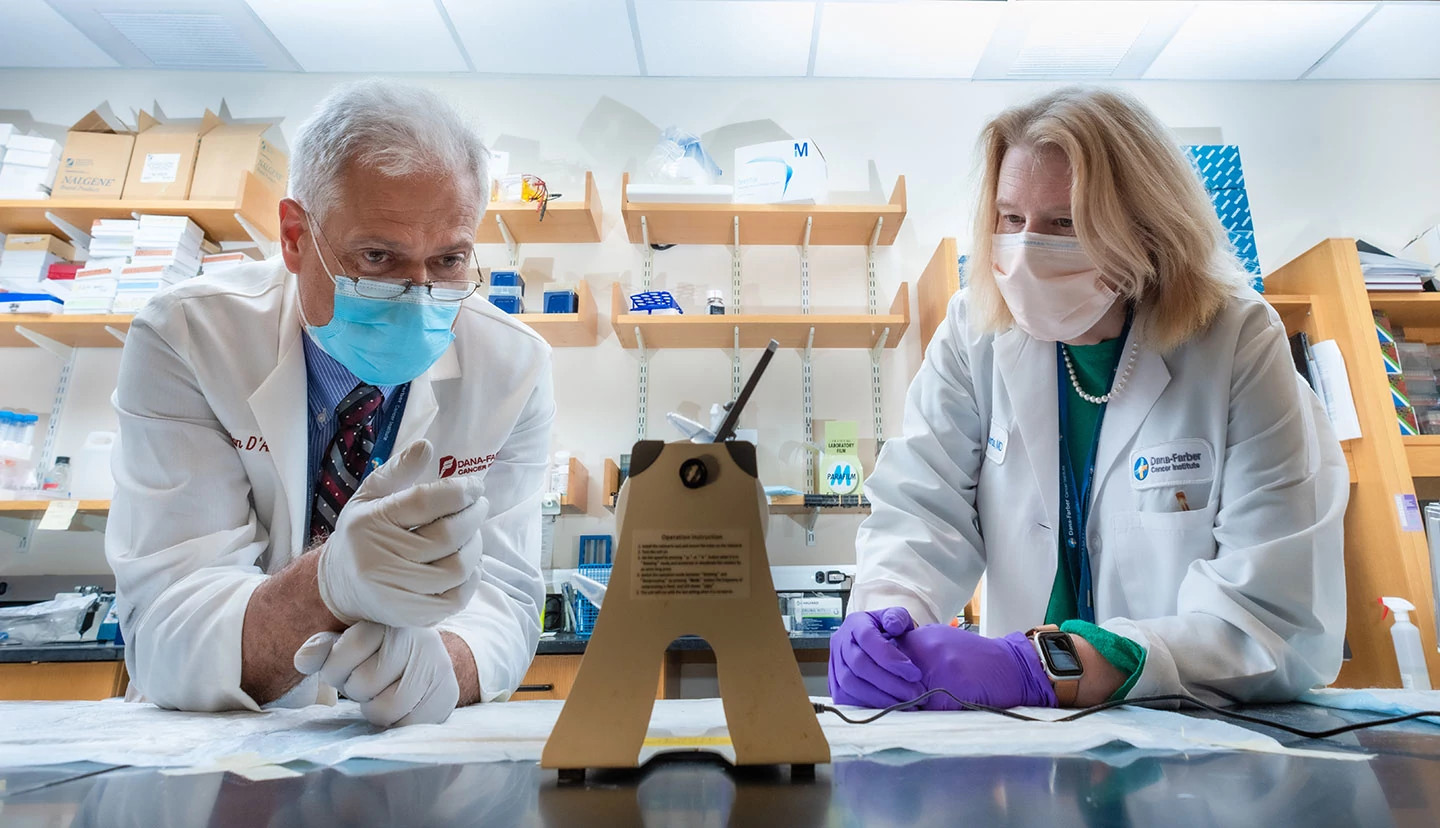
New Strategies for When Cancer Finds a Way Around Common Treatments
November 15, 2021
BRCA
Gynecologic Cancer
Breast Cancer
By Robert Levy
For cancer cells, making mistakes is a survival strategy. Unstable and erratic, they reproduce with such abandon that bothersome details like accurately copying their DNA often get neglected. The result is a skein of genetic mutations and irregularities that can make malignant cells extraordinarily difficult to pin down, either by the body's immune defenses or by medical interventions.
Cancer's error-prone ways are partly responsible for the problem of drug resistance, the all-too-common situation in which a medicine that initially threw cancer into remission or slowed its growth seems to tire out, allowing the cancer to return. The fault isn't within the drug itself, but within the cancer: as new mutations crop up, they may give tumor cells the ability to stand up to drugs that previously would have killed them.
Drug resistance constitutes one of the toughest challenges in cancer medicine, and one of the most active fields of research. If resistance didn't occur – if cancer presented a consistent, steady target to therapy – then any agent that shrank a tumor or kept it in check could be counted on to maintain that effectiveness over the long term.
Resistance impacts the treatment of breast and gynecologic cancer in a variety of ways. About 90% of primary breast cancers and 50% of metastatic breast cancers respond to initial drug therapy, sometimes virtually vanishing. Months or years later, however, the disease can come back, usually in a drug-resistant form. Even ovarian cancer, which in most cases isn't diagnosed until it has reached an advanced stage, generally shrinks after its first course of platinum-based chemotherapy. Unfortunately, 75-80% of patients experience a recurrence. A second round of chemotherapy often sends the disease into remission, but over time new, resistant tumors can emerge.
When therapy of any kind doesn't eradicate a patient's cancer, the surviving tumor cells can set the stage for a return of the disease. 
"When therapy of any kind doesn't eradicate a patient's cancer, the surviving tumor cells can set the stage for a return of the disease," says Ursula Matulonis, MD, chief of the Division of Gynecologic Oncology at Dana-Farber. "Understanding how cells become resistant to treatment, and how we can overcome resistance, is critical to improving outcomes for our patients. At the Susan F. Smith Center for Women's Cancers, we're working to shed light on these resistance mechanisms."
Shifting Gears When Tumors Return
Tumors can foil cancer drugs in a variety of ways. If a drug targets a particular protein in a cell-growth pathway, a genetic mutation may alter that protein so it eludes the drug's grasp. If one part of a growth pathway is shut down by a drug, a mutation may provide a detour around it, much as a stream, if dammed, may form new branches to reach its destination. Mutations can produce changes in proteins on the cell surface that prevent cancer drugs from binding there. Some tumor cells even develop the ability to pump out drugs that have breached their membranes.
Metastasis is another part of cancer's evasive repertoire. "However cancer cells spread – via the bloodstream, the lymph system, or even through direct spread in the abdomen to areas such as the omentum [a fatty structure that drapes the intestines and is a common site for metastatic ovarian cancer] – they may grow differently depending on their environment or 'neighborhood' they're in, and they also may respond differently to treatment depending on the organ or tissue they're in," Dr. Matulonis observes. "Even within a single patient, different sets of tumor cells may exhibit different mechanisms of resistance."
To deal with these ploys, scientists are working on a range of countermeasures. They're developing techniques to destroy, rather than merely block, proteins involved in drug resistance. They're testing whether different drug doses or treatment schedules can prevent resistance or reduce its likelihood. Most promisingly, they're working to decipher the genetic mechanisms behind resistance, looking for ways to block or circumvent them.
Today, when a patient's tumor stops responding to a drug or combination of drugs, physicians may recommend another regimen or a clinical trial of a novel treatment. But because tumors can become resistant to multiple therapies, new approaches are urgently needed.
What to Do When PARP Inhibitors Fail
A recent study by Dana-Farber researchers exemplifies science's ability to get the upper hand over cancer drug resistance. Drugs known as PARP inhibitors have become a major part of the arsenal against cancers with mutations in the genes BRCA1 and BRCA2. The drugs employ the same strategy as a trade embargo against an outlaw nation. If some of that country's supply lines have already been disrupted, it's likely to be desperately dependent on its remaining suppliers. Shutting down those sources would be devastating. BRCA1 and 2 help cells repair double-stranded breaks in their DNA. When those genes are knocked out of commission by a mutation, tumor cells rely more heavily on PARP proteins, which make single-stranded DNA repairs. Blocking the PARP proteins with an inhibitor drug can create such a build-up of genetic damage that the tumor cells die.

"BRCA mutations are found in many breast, ovarian, prostate, and some pancreatic cancers," says Alan D'Andrea, MD, director of Dana-Farber's Susan F. Smith Center for Women's Cancers and the Center for DNA Damage and Repair, who led the new study with Raphael Ceccaldi, PhD, PharmD, of the Curie Institute in Paris. "For many patients with these cancers, or cancers with other DNA-repair deficiencies, PARP inhibitors can be extremely effective."
In nearly every case, though, tumors that were once susceptible to PARP inhibitors become resistant to them and mount a comeback, leaving patients in need of new options. Dr. D'Andrea and his team set out to find one. At a Harvard Medical School facility, they screened thousands of molecules – approved drugs as well as experimental compounds – in BRCA-deficient tumors to see if they had any effect on tumor growth. The screenings were conducted in laboratory cell lines, in organoids – three-dimensional cultures of tumor tissue – and in animal models.
Of all the drugs tested, one stood out for its ability to kill the tumor cells while leaving normal cells unharmed – the antibiotic novobiocin. When they learned the identity of the protein that novobiocin targets within cells, they had a shock of recognition.
Back in 2015, Dr. D'Andrea's team had found that tumors with poorly functioning BRCA1 and 2 genes are overdependent for their growth and survival on an enzyme called POLθ, or POLQ. Like the BRCA proteins, POLQ specializes in mending double-strand DNA breaks. In tumors with mutated BRCA genes, the POLQ pathway becomes all the more vital, and any drug that targets it could deliver a death blow to cells. Now, in the new study, Dr. D'Andrea's team had discovered that novobiocin's protein target was none other than POLQ.

Novobiocin: An Old Drug Reborn to Treat Ovarian Cancer
Novobiocin is a drug whose best days were thought to be behind it. Originally developed in the 1950s and licensed for patients in the 1960s, it gradually fell into disuse as newer, more versatile antibiotics came on the market. Its primary use today is in veterinary medicine.
As Dr. D'Andrea and his colleagues searched the medical literature for reports on novobiocin, they found that this wasn't the first time it has been studied as a potential cancer drug. Nearly 30 years ago, investigators had tested it in clinical trials for patients with hard-to-treat cancers. Most of the patients didn't benefit from the drug, but a handful did, having their cancer stabilize or recede.
"At the time, no one knew what the drug's target was," Dr. D'Andrea remarks. "Now we do, and, as a result, we have an indication of which patients are likely to be helped by it." To see if novobiocin works as well in people as it has in the laboratory and in animal models, investigators are launching a phase 1 clinical trial of the drug in late 2021 for patients with ovarian cancer whose tumors have defects in BRCA or other genes involved in DNA repair. Geoffrey Shapiro, MD, PhD, who will lead the trial, has high hopes for its success.
"The discovery of novobiocin's potential in BRCA-deficient cancers is an example of how research at the basic, molecular level can pave the way to better treatments for patients," Dr. D'Andrea says. "It's an early indication of how powerful this approach can be in solving the problem of drug resistance."